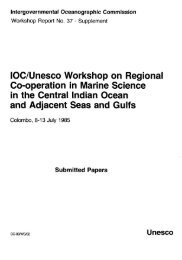Manual on sea level measurement and ... - unesdoc - Unesco
Manual on sea level measurement and ... - unesdoc - Unesco
Manual on sea level measurement and ... - unesdoc - Unesco
- No tags were found...
You also want an ePaper? Increase the reach of your titles
YUMPU automatically turns print PDFs into web optimized ePapers that Google loves.
Sea Level Measurement <strong>and</strong> Interpretati<strong>on</strong>comp<strong>on</strong>ents of the <strong>sea</strong> <strong>level</strong> variati<strong>on</strong>s (e.g. storm surges,tsunami) <strong>and</strong> the l<strong>on</strong>g-term trend.Many organizati<strong>on</strong>s have developed their own methodof tidal analysis. Apart from the Resp<strong>on</strong>se Method (Munk<strong>and</strong> Cartwright, 1966), these methods generally fit, insome optimal way, a set of harm<strong>on</strong>ic c<strong>on</strong>stituents tothe data. This can be d<strong>on</strong>e in several different ways. TheAdmiralty Semi-Graphic Method <strong>and</strong> those of Doods<strong>on</strong>(1928) were designed for h<strong>and</strong> calculati<strong>on</strong>s. Most moderntechniques (Murray, 1963; Foreman, 1997) rely <strong>on</strong> theability of the computer to solve large sets of simultaneousequati<strong>on</strong>s. Many have been c<strong>on</strong>verted to ‘user friendly’packages <strong>and</strong> are available from the following website:http://www.pol.ac.uk/psmsl/training/analysis.html.2.5 Storm SurgesThe exchange of energy between the atmosphere <strong>and</strong> theocean is <strong>on</strong>e of the most important topics in geophysics.Storm surges are am<strong>on</strong>g the more spectacular examplesof energy transfer in which the energy c<strong>on</strong>tained in winds<strong>and</strong> time-dependent changes in air pressure are absorbedby the <strong>sea</strong> to produce str<strong>on</strong>g currents <strong>and</strong> high <strong>sea</strong> <strong>level</strong>s.In the open <strong>sea</strong> these currents decay by the acti<strong>on</strong> of dissipativeforces. Where the current is impeded by the presenceof a c<strong>on</strong>tinental shelf or other disc<strong>on</strong>tinuity in depth,or by a coastline, more of the kinetic energy of the <strong>sea</strong>tends to be c<strong>on</strong>verted into potential energy. Abnormalelevati<strong>on</strong>s of <strong>sea</strong> <strong>level</strong> may then occur, with disastrousresults if the coast is low-lying.Physically, the atmosphere acts <strong>on</strong> the <strong>sea</strong> in two distinctlydifferent ways. The first is the ‘Inverse Barometer (IB)Effect’ wherein a 1-hPa (mbar) increase of atmosphericpressure decreases <strong>sea</strong> <strong>level</strong> by 1 centimetre. (Dynamicaleffects can complicate this simple IB descripti<strong>on</strong> at shorttime-scales.) The sec<strong>on</strong>d is due to the drag (or ‘stress’)of the wind <strong>on</strong> the <strong>sea</strong> surface, which is proporti<strong>on</strong>al (toa first approximati<strong>on</strong>) to the square of the wind speed.This force sets up <strong>sea</strong> <strong>level</strong> gradients which are proporti<strong>on</strong>alto wind stress divided by water depth, <strong>and</strong> whichresult in the storm surges in shallow water regi<strong>on</strong>s. Thedynamics of surges in shallow water result in flow beingin the directi<strong>on</strong> of the wind, differing from a deeperwater situati<strong>on</strong> in which the transport is at right anglesto the wind (to the right in the northern hemisphere).Recordings of <strong>sea</strong> <strong>level</strong> at any coastal stati<strong>on</strong> c<strong>on</strong>tainsome evidence of the influence of winds <strong>and</strong> pressure,but some areas are particularly susceptible to largesurges. The Baltic, being virtually an enclosed <strong>sea</strong> <strong>and</strong>subject <strong>on</strong> occasi<strong>on</strong> to severe gales, experiences largesurges. In 1924 St. Petersburg (Leningrad) was floodedby a surge 4 m high. The North Sea, with its southernextremity almost closed, resp<strong>on</strong>ds readily to northerlywinds; the vulnerable coastlines of the German Bight,eastern Engl<strong>and</strong> <strong>and</strong> more particularly the Low Countrieshave repeatedly been inundated by great surges. Thestorm surge of 1953 resulted in many deaths in TheNetherl<strong>and</strong>s <strong>and</strong> Engl<strong>and</strong>. The Hamburg disaster of1962 was more localized, mainly affecting the GermanBight <strong>and</strong> the River Elbe, where the surge reached morethan 3 m in height.Hurricanes travelling towards the Atlantic <strong>sea</strong>board ofthe United States are no less effective in generatingdestructive surges. The Japanese isl<strong>and</strong>s are also subjectto typho<strong>on</strong> surges. Events <strong>on</strong> this scale dem<strong>and</strong> as completean underst<strong>and</strong>ing of the phenomena as possibleso that they may be forecast (using forecast meteorologicalinformati<strong>on</strong>) <strong>and</strong> their c<strong>on</strong>sequences mitigated.After the immediate danger of flooding, the subsequentdislocati<strong>on</strong> of normal services, such as water supplies<strong>and</strong> sewerage, gives rise to serious dangers. Also, <strong>on</strong>ceflooded by <strong>sea</strong> water, previously fertile l<strong>and</strong>s are unsuitablefor growing crops for several years because ofthe saline deposit which remains after the floods havereceded.For scientific analysis <strong>and</strong> for systems designed for surgepredicti<strong>on</strong>, it is usual to distinguish between tropical <strong>and</strong>extra-tropical surges.Tropical surges are generated by tropical storms that aresmall <strong>and</strong> very intense. These storms are generated at<strong>sea</strong>, from where they move in an irregular way until theymeet the coast. Here they produce excepti<strong>on</strong>ally largeflood <strong>level</strong>s over a regi<strong>on</strong> of perhaps 10–50 km of coastline.Tropical storms are difficult to m<strong>on</strong>itor offshore <strong>and</strong>their effects <strong>on</strong> a particular stretch of coastline cannot beestimated from the statistics of observed floods becausesuch storms are relatively rare events in any particularregi<strong>on</strong>. A combinati<strong>on</strong> of numerical <strong>and</strong> statistical modelsmay be used to estimate the maximum flood <strong>level</strong>s,but their exact locati<strong>on</strong> depends <strong>on</strong> the track of eachindividual storm.Extra-tropical surges are generated by storms whichextend over several hundred kilometres <strong>and</strong> which aregenerally slow moving. They affect large areas of coastover periods that may extend to several days. At theircentre is a regi<strong>on</strong> of low atmospheric pressure. They aremore amenable to study by hydrodynamic modellingtaking into account the distributi<strong>on</strong> of atmospheric pressure<strong>and</strong> wind fields, <strong>sea</strong> bed bathymetry, the coastaltopography <strong>and</strong> the effects of the Earth’s rotati<strong>on</strong>.A tide gauge network by which the storm surge canbe m<strong>on</strong>itored is of key importance in providing data toenhance the performance of operati<strong>on</strong>al hydrodynamictide–surge models used in flood warning. Data canbe used in the verificati<strong>on</strong> of the models <strong>and</strong> for dataassimilati<strong>on</strong> into them (Flather, 2000; Alvarez Fanjul,2001). Such a network clearly has to be capable ofremote telemetry <strong>on</strong> a near-real-time basis.6IOC <str<strong>on</strong>g>Manual</str<strong>on</strong>g>s <strong>and</strong> Guides No 14 vol IV
















